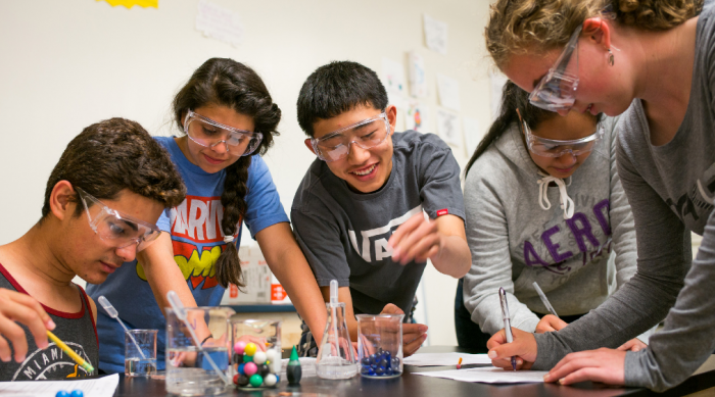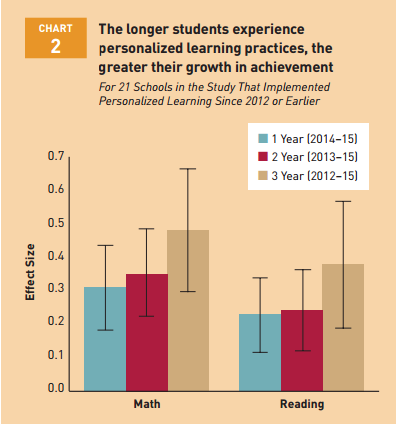Personalized Learning is (Still) Promising
Topics

We’ve all had the experience of truly purposeful, authentic learning and know how valuable it is. Educators are taking the best of what we know about learning, student support, effective instruction, and interpersonal skill-building to completely reimagine schools so that students experience that kind of purposeful learning all day, every day.
Practitioner's Guide to Next Gen Learning
A second year of data is in, and personalized learning is still promising.
A second year of data is in, and personalized learning is still promising. (For a recap of the first year of data, see my post from last year.)
The Bill & Melinda Gates Foundation and the RAND Corporation released Continued Progress: Promising Evidence on Personalized Learning last month. Here’s the headline about the research:
"Students in schools using personalized learning strategies made greater academic progress, over the course of two years, than a comparison group of similar students."
At NGLC, we find that when we talk about personalized learning, and describe how schools are implementing blended learning and embracing competency-based learning, people want to know if there’s any evidence that this shift in teaching and learning is worth it. Is it just another fad with fancy tech bells and whistles, or is it actually better than what teachers and schools have been doing successfully for a long time?
This is an important question. There’s so much churn in K-12 education. Frequent leadership changes lead to frequent changes in favorite initiatives. General reform fatigue is a common affliction among today’s educators as “silver bullet” solutions are adopted and then dropped in favor of the next solution to come along.
But personalized learning is different because it requires a total shift in philosophy, culture, and strategy of school.
I’ve heard teachers say, after adopting personalized learning, “I will never go back to teaching the old way. I know so much more about my students now than I ever did before.”
Matchbook Learning’s CEO, Sajan George, has said, “I’d rather fail at this than actually be ‘successful’ at anything else” to emphasize how critically important he finds personalized learning.
But does it work?
With the release of Continued Progress, we now have two years of data that are pointing to the answer of “yes.” Since definitive evidence is not determined with just two years of data in a select number of schools, the answer can’t be a definitive “yes.” But it’s promising, and the consistency between the two years adds a little more weight to the data.
The Schools
The study included 62 public schools, among them schools funded by NGLC, Charter School Growth Fund, and the Gates Foundation’s Personalized Learning Pilots. Ninety (90) percent of the schools are public charters and 10 percent are district schools. Almost half of the schools are elementary schools, 32% are middle schools, 21% high schools, and 2% K-8.
The schools have not adopted a single specific model of personalized learning--their learning designs vary. But these five strategies are often used:
- Learner profiles
- Personal learning paths
- Competency-based progression
- Flexible learning environments
- Emphasis on college and career readiness
Personalized learning is a schoolwide model for these schools, not a strategy used in individual classrooms or courses.
Student Achievement
Students in the 62 schools improved their math and reading performance over the past two years. These results are based on student performance on NWEA’s MAP. For the 21 schools with three years of data, the study found that “the longer students experience personalized learning practices, the greater their growth in achievement.”

The average growth among the 11,000 students in the 62 schools was significantly better than a virtual comparison group (all the limitations and cautions of interpreting non-experimental research apply). The effects were larger in the elementary grades and not statistically different from the comparison group in grades 9-12.
Students in the personalized learning schools started at performance levels that were below national averages, but after two years their achievement “jumped above the national median.” The lowest-performing students made the greatest gains.
Positive gains were evident in most of the schools. But five of the 62 schools demonstrated significant negative effects in math in relation to the comparison group, and seven schools demonstrated significant negative effects in reading. There are likely many reasons for the variation in outcomes among the 62 schools. If we could understand if the models of those seven schools differ from the models implemented in the other schools along specific practices or strategies, we might be able to start identifying best practices that can move the field to stronger, more consistent outcomes for students.
The report begins to attempt this. In another post, I’ll share the study’s findings on implementation of the five personalized learning strategies and connections between implementation and student achievement outcomes.
Evidence of Impact Project
NGLC has commenced an effort to build on the RAND study to collect multiple measures of impact from NGLC schools themselves. While RAND measures growth in reading and math on one assessment, many grantees have developed a set of rigorous and robust methods to measure the impact of their innovations. The upcoming report will share some of the work of grantees in demonstrating and measuring impact in an effort to learn from next generation learning. See Measures That Matter Most.




